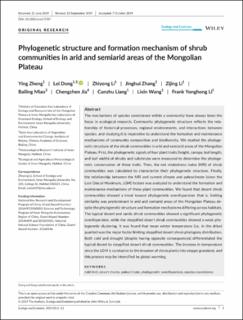Please use this identifier to cite or link to this item:
https://doi.org/10.21256/zhaw-19169Full metadata record
| DC Field | Value | Language |
|---|---|---|
| dc.contributor.author | Zheng, Ying | - |
| dc.contributor.author | Dong, Lei | - |
| dc.contributor.author | Li, Zhiyong | - |
| dc.contributor.author | Zhang, Jing Hui | - |
| dc.contributor.author | Li, Zijing | - |
| dc.contributor.author | Miao, Bailing | - |
| dc.contributor.author | Jia, Chengzhen | - |
| dc.contributor.author | Liang, Cunzhu | - |
| dc.contributor.author | Wang, Lixin | - |
| dc.contributor.author | Li, Frank Yonghong | - |
| dc.date.accessioned | 2020-01-23T14:51:53Z | - |
| dc.date.available | 2020-01-23T14:51:53Z | - |
| dc.date.issued | 2019 | - |
| dc.identifier.issn | 2045-7758 | de_CH |
| dc.identifier.uri | https://digitalcollection.zhaw.ch/handle/11475/19169 | - |
| dc.description.abstract | The mechanisms of species coexistence within a community have always been the focus in ecological research. Community phylogenetic structure reflects the relationship of historical processes, regional environments, and interactions between species, and studying it is imperative to understand the formation and maintenance mechanisms of community composition and biodiversity. We studied the phylogenetic structure of the shrub communities in arid and semiarid areas of the Mongolian Plateau. First, the phylogenetic signals of four plant traits (height, canopy, leaf length, and leaf width) of shrubs and subshrubs were measured to determine the phylogenetic conservation of these traits. Then, the net relatedness index (NRI) of shrub communities was calculated to characterize their phylogenetic structure. Finally, the relationship between the NRI and current climate and paleoclimate (since the Last Glacial Maximum, LGM) factors was analyzed to understand the formation and maintenance mechanisms of these plant communities. We found that desert shrub communities showed a trend toward phylogenetic overdispersion; that is, limiting similarity was predominant in arid and semiarid areas of the Mongolian Plateau despite the phylogenetic structure and formation mechanisms differing across habitats. The typical desert and sandy shrub communities showed a significant phylogenetic overdispersion, while the steppified desert shrub communities showed a weak phylogenetic clustering. It was found that mean winter temperature (i.e., in the driest quarter) was the major factor limiting steppified desert shrub phylogeny distribution. Both cold and drought (despite having opposite consequences) differentiated the typical desert to steppified desert shrub communities. The increase in temperature since the LGM is conducive to the invasion of shrub plants into steppe grassland, and this process may be intensified by global warming. | de_CH |
| dc.language.iso | en | de_CH |
| dc.publisher | Wiley | de_CH |
| dc.relation.ispartof | Ecology and Evolution | de_CH |
| dc.rights | https://creativecommons.org/licenses/by/4.0/ | de_CH |
| dc.subject | Cold limit | de_CH |
| dc.subject | Desert shrub | de_CH |
| dc.subject | Paleoclimate | de_CH |
| dc.subject | Phylogenetic overdispersion | de_CH |
| dc.subject | Species coexistence | de_CH |
| dc.subject.ddc | 577: Ökologie | de_CH |
| dc.subject.ddc | 580: Pflanzen (Botanik) | de_CH |
| dc.title | Phylogenetic structure and formation mechanism of shrub communities in arid and semiarid areas of the Mongolian Plateau | de_CH |
| dc.type | Beitrag in wissenschaftlicher Zeitschrift | de_CH |
| dcterms.type | Text | de_CH |
| zhaw.departement | Life Sciences und Facility Management | de_CH |
| zhaw.organisationalunit | Institut für Umwelt und Natürliche Ressourcen (IUNR) | de_CH |
| dc.identifier.doi | 10.1002/ece3.5787 | de_CH |
| dc.identifier.doi | 10.21256/zhaw-19169 | - |
| dc.identifier.pmid | 31871647 | de_CH |
| zhaw.funding.eu | No | de_CH |
| zhaw.issue | 23 | de_CH |
| zhaw.originated.zhaw | Yes | de_CH |
| zhaw.pages.end | 13331 | de_CH |
| zhaw.pages.start | 13320 | de_CH |
| zhaw.publication.status | publishedVersion | de_CH |
| zhaw.volume | 9 | de_CH |
| zhaw.publication.review | Peer review (Publikation) | de_CH |
| zhaw.webfeed | Vegetationsökologie | de_CH |
| zhaw.author.additional | No | de_CH |
| Appears in collections: | Publikationen Life Sciences und Facility Management | |
Files in This Item:
| File | Description | Size | Format | |
|---|---|---|---|---|
| Phylogenetic_structure_and_formation_mechanism_of_.pdf | 1.19 MB | Adobe PDF |  View/Open |
Show simple item record
Zheng, Y., Dong, L., Li, Z., Zhang, J. H., Li, Z., Miao, B., Jia, C., Liang, C., Wang, L., & Li, F. Y. (2019). Phylogenetic structure and formation mechanism of shrub communities in arid and semiarid areas of the Mongolian Plateau. Ecology and Evolution, 9(23), 13320–13331. https://doi.org/10.1002/ece3.5787
Zheng, Y. et al. (2019) ‘Phylogenetic structure and formation mechanism of shrub communities in arid and semiarid areas of the Mongolian Plateau’, Ecology and Evolution, 9(23), pp. 13320–13331. Available at: https://doi.org/10.1002/ece3.5787.
Y. Zheng et al., “Phylogenetic structure and formation mechanism of shrub communities in arid and semiarid areas of the Mongolian Plateau,” Ecology and Evolution, vol. 9, no. 23, pp. 13320–13331, 2019, doi: 10.1002/ece3.5787.
ZHENG, Ying, Lei DONG, Zhiyong LI, Jing Hui ZHANG, Zijing LI, Bailing MIAO, Chengzhen JIA, Cunzhu LIANG, Lixin WANG und Frank Yonghong LI, 2019. Phylogenetic structure and formation mechanism of shrub communities in arid and semiarid areas of the Mongolian Plateau. Ecology and Evolution. 2019. Bd. 9, Nr. 23, S. 13320–13331. DOI 10.1002/ece3.5787
Zheng, Ying, Lei Dong, Zhiyong Li, Jing Hui Zhang, Zijing Li, Bailing Miao, Chengzhen Jia, Cunzhu Liang, Lixin Wang, and Frank Yonghong Li. 2019. “Phylogenetic Structure and Formation Mechanism of Shrub Communities in Arid and Semiarid Areas of the Mongolian Plateau.” Ecology and Evolution 9 (23): 13320–31. https://doi.org/10.1002/ece3.5787.
Zheng, Ying, et al. “Phylogenetic Structure and Formation Mechanism of Shrub Communities in Arid and Semiarid Areas of the Mongolian Plateau.” Ecology and Evolution, vol. 9, no. 23, 2019, pp. 13320–31, https://doi.org/10.1002/ece3.5787.
Items in DSpace are protected by copyright, with all rights reserved, unless otherwise indicated.